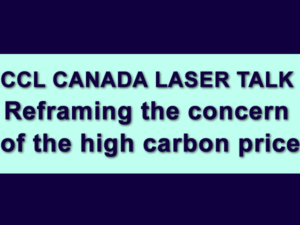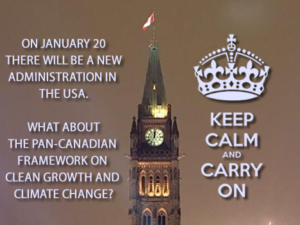Carbon Capture and Storage (CCS) is a general term for a range of different industrial processes that can separate carbon dioxide (CO2) emissions from smokestacks and store it underground indefinitely as toxic waste. CCL does not oppose or support any specific technologies. The science is clear, we will need to deploy CCS in order to attain the 1.5C goal. One of the key reasons CCS is necessary is because heavy industry – fertilizer producers, steel mills, and cement makers – would be difficult and expensive to adapt to run on cleaner energy. Without policy support such as adequate carbon pricing, CCS deployed at scales required to meet climate targets is unlikely. According to the International Energy Agency, CCS facilities currently capture almost 45 megatonnes of CO2 globally, but this needs to increase. Project developers have announced ambitions for over 200 new capture facilities to be operating by 2030, capturing over 220 Mt CO2 per year. However, only around 10 commercial capture projects under development have taken the official “go ahead” (FID) as of June 2022. Nevertheless, even at such a level, CCS deployment would remain substantially below what is required in the Net Zero Scenario by 2050. This is now even more urgent in that we are in a Net Zero Scenario by 2040 (IPCC AR6 Synthesis Report). CCL Canada is fully supportive of the UN High-Level Expert Group on net-zero commitments (HLEG) report Integrity matters: Net zero commitments by businesses, financial institutions, cities, and regions. One of the key recommendations is that technologies must come as advertised. One of the key conclusions of the final IPCC AR6 synthesis report (March 2023) was clear – no new fossil fuel infrastructure can be built. Given the inequitable and catastrophic impact that exceeding a global temperature rise of 1.5 °C will have on everything and everywhere, planning for any new fossil fuel infrastructure on the premise that it can be reversed by unproven carbon capture and sequestration funded by taxpayers is indefensible. Carbon Capture and Storage (CCS) is a general term for a range of different industrial processes that can separate carbon dioxide (CO2) emissions from smokestacks and store it underground indefinitely as toxic waste. CCS can reduce and even eliminate carbon emissions from power plants, refineries, cement kilns, steel furnaces, and other industrial facilities. When combined with biofuels, it can permanently reduce CO2 levels in the atmosphere.1 Canada is a world leader in CCS technology.2 CO2 emissions are usually mixed with nitrogen, water vapour, and other flue gases which must be separated out. This accounts for three-quarters of the cost of CCS.3 Research is still ongoing to find the “best” ways to do this.4 Some industrial processes (e.g. calcination) have very pure CO2 exhaust that is easier to capture with less expensive equipment. But in most cases, chemicals must be separated either before (e.g. oxyfuel combustion) or after (e.g. amine gas treatment) combustion. The biochar process reduces the carbon to a solid instead of CO2 gas, but it comes with a heavy energy penalty. Some small- scale experimental systems feed the exhaust to algae and let photosynthesis extract the CO2. Solid carbon can be buried at shallow depths, but CO2 gas must be stored deep underground. Most of the CO2 captured today is injected into oil wells for Enhanced Oil Recovery, (EOR) which should properly be called Carbon Capture and Utilization (CCU).5 Several truly permanent storage options are being tested to evaluate their costs, availability, capacity and longevity. These include saline aquifers, depleted gas wells, basaltic rock, and biochar. There is not yet any guarantee that widely feasible solutions exists, but there have been some notably successful demonstrations. Norway’s Sleipner project has been pumping 1 MtCO2 per year into the Utsira saline aquifer since 1996 for $17 per ton, and seismometry, gravitometry, and seafloor surveys show that the CO2 is not leaking.6 The fossil industry has historically pursued CCU to increase fossil fuel production, because it was profitable to do so. But the right economic incentives can promote the development of true CCS variants that reduce emissions.7 The Pembina Institute cautiously supports CCS as part of a portfolio of solutions if it works as planned, and governments share ownership.8,9 CCL is technology neutral, but wants carbon pricing to distinguish between the different kinds of CCS based on their actual carbon impact. References: 2 CCL Laser Talk on Carbon Capture and Storage in Canada 3 A. Al-Mamoori, A. Krishnamurthy, A. A. Rownaghi, F. Rezaei, “Carbon Capture and Utilization Update”, Energy Technology 2017, 5, 834. http://onlinelibrary.wiley.com/doi/10.1002/ente.201600747/full 4 “Conditions for Capture” Nature Energy 2, Article 17141 (2017), 08 August 2017, doi:10.1038/nenergy.2017.141 https://www.nature.com/articles/nenergy2017141 5 “Carbon Capture and Utilization”, Integrated CO2 Network (ico2n), Duncan Kenyon & Binnu Jeyakumar, 2015 Mar 15 http://www.pembina.org/pub/carbon-capture-and-utilization 6 ECO2 – Sub-seabed CO2 Storage: Impact on Marine Ecosystems, Final Publishable Summary Report, http://www.eco2- project.eu/ 7 CCL Laser Talk on Carbon Capture and Storage Subsidies 8 “The Pembina Institute’s Perspective on Carbon Capture and Storage (CCS)”, Pembina Institute, Feb 19, 2009 http://www.pembina.org/pub/1787 Carbon capture can be used to increase, decrease, or even reverse carbon emissions, depending on how the technology is applied.1 It can be used to bury carbon dioxide (CO2) permanently underground, instead of releasing it into the atmosphere. But it was first developed and is primarily used to assist fossil fuel production, while increasing emissions. In the future, it may be used not just to prevent emissions, but to actually remove CO2 from the atmosphere. Large-scale Carbon Dioxide Removal (CDR) of some kind is necessary to keep the Earth within 2°C of pre-industrial temperatures.2 The main difference between good or bad CCS is where the carbon goes after capture. Most captured CO2 is used for Enhanced Oil Recovery (EOR) rather than being stored. This generally brings more carbon to the surface than is injected into the ground.3 Acid gas disposal and biogenic coalbed methane are similarly polluting. These projects are properly called Carbon Capture and Utilization (CCU), while true Carbon Capture and Storage (CCS) does not draw any new fossil fuels in exchange for the injection.4 True CCS locks the carbon in saline aquifers, depleted gas wells, basaltic rock, or biochar. It also matters where the captured carbon came from. CCS is often used to justify new fossil fuel infrastructure, even though it will only capture a fraction of the new emissions. But if it is retrofitted onto existing facilities, it can act as a bridge technology.5 It can even produce negative emissions if installed on a biofuel plant. Without CCS, bioenergy is carbon neutral because biomass absorb as much carbon while growing as it emits when burned. But if bioenergy emissions are captured and stored, (BECCS) the overall cycle permanently removes CO2 from the atmosphere. The Illinois Decatur plant is the first in the world to test this idea. Unfortunately, the corn grown for Decatur competes for land with food production and forests. Land use can be minimized with second-generation biofuels made from agricultural waste or grown on marginal land, but land will always limit the deployment of BECCS.6 It can assist, but not replace, global reductions in fossil fuel emissions. Reforestation is a more natural way to achieve CDR, but its potential is even more limited by productive land area.7 Other CDR options such as ocean fertilization are less reliable and carry risks of unintended consequences.8 BECCS has great potential with low risks, but it needs subsidies to gain a financial advantage over fossil fuel CCS and over freely emitting biofuels.9 References: 2 “Large-scale deployment of CDR technologies is relied upon in many 2°C scenarios in the second-half of the century.” IPCC 5th Assessment Report, Working Group III, Chapter 6, p. 419 3 For example, Canada’s Weyburn oilfield production is increased by 18000 barrels/day by injecting 6500 ton/day of CO2.The extra production turns into 7700 ton/day of CO2 when it is eventually burned. A third of the injected CO2 returns to the surface, but is then captured and reinjected. http://ccs101.ca/ccs_pro/ccs_projects/commercial_projects 5 “The CCS can also act as bridge technology that is compatible with existing fossil-fuel dominated supply structures.” IPCC 5th Assessment Report, Working Group III, Chapter 6, p. 453 6 “Both BECCS and afforestation may play a key role in reaching low-GHG concentrations, but at a large scale have substantial land-use demands that may conflict with other mitigation strategies and societal needs such as food production.” IPCC 5th Assessment Report, Working Group III, Chapter 6, p. 489 7 “An order of magnitude of the upper potential of afforestation/ reforestation would be the restoration of all the carbon released by historical land use (180 ± 80 PgC). […] the atmospheric CO2 concentration by 2100 would be lowered by only about 40 to 70 ppm in that scenario.” IPCC 5th Assessment Report, Working Group I, Chapter 6, p. 547. 8 “Most assessments agree that geoengineering technologies should not be treated as a replacement for conventional mitigation and adaptation due to the high costs […] and the potential risks, or pervasive uncertainties involved with nearly all techniques” IPCC 5th Assessment Report, Working Group III, Chapter 6, p. 484. 9 CCL Laser Talk on Carbon Capture and Storage Subsidies The global Carbon Capture and Storage (CCS) industry already captures 40 MtCO2 per year, about 0.1% of global emissions.1 Canadian projects already make up 12% of that figure, and even larger projects are coming. The Fort Nelson Gas Plant will capture 2 MtCO2 per year, and the Alberta Carbon Trunk Line (ACTL) will add up to another 15 MtCO2 per year. Canada is a world leader in CCS technology and has already broken three world records: SaskPower made global headlines in 2014 when Boundary Dam unit 3 (BD3, of six) became the first commercial electricity plant with CCS. This was a retrofit onto a preexisting coal plant, demonstrating that emissions can be drastically reduced without stranding expensive assets and laying off workers. As of summer 2017, its CCS system continues to face reliability problems. In spite of this, BD3 output averaged 108 MW at 0.3 kgCO2 per kWh in 2016.2 This is as much power as a typical gas turbine but with much lower CO2 emissions and a competitive levelized cost of electricity of 8¢/kWh.3 Emissions are expected to fall to 0.1 kgCO2 per kWh of electricity if the system can be refit to work as designed.4 Federal and provincial subsidies to the project amount to $57/ton of CO2 captured over the 30-year life of the project.5 (However, the 2016 cost was closer to $92/ton due to reliability problems.6) No private company would have taken on such costs without subsidies.7 Some of Boundary Dam’s CO2 has been injected into the Aquistore saline aquifer, but most of it is sent to the Weyburn field.3 The Weyburn-Midale oilfield collects CO2 from several CCS projects since 2000 and uses it for Enhanced Oil Recovery. EOR brings more carbon to the surface than is sent down.8 This field held the world record for most cumulative carbon injected until recently. There are half a dozen other CCS projects ongoing in Canada, of which we can only detail the most noteworthy. The Quest project built in 2015 takes 1MtCO2 per year from the Scotford oil sands upgrader and stores it permanently in a saline aquifer for $45/ton. Quest narrowly beats out Norway’s Sleipner-Utsira for the highest flow rate into a saline aquifer in the world, but that record will soon be upset again by B.C.’s Fort Nelson Gas Plant. A startup called Pond Biofuels developed a novel algae capture system in 2016 for St. Marys Cement plant, capturing 0.04 MtCO2 per year for $30/ton. References: 2 Author’s calculations, based on average of 108 MW in 2016 and capturing 0.793 MtCO2 per SaskPower, “BD3 Status Update: December 2016”, published January 5, 2017 http://www.saskpower.com/about-us/blog/bd3-status-update- december-2016/; (1.1 MtCO2 (spec.4) – 0.793 MtCO2 (reported) ) / ( 108 MW X 366 days X 24 hr/day) = 0.3 kg/kWh 3 “An update on the SaskPower Boundary Dam Project”, Global CCS Institute, 17 Jul 2013 4 SaskPower, CCS performance data exceeding expectations at world-first Boundary Dam Power Station Unit #3, February 11, 2015, http://www.saskpower.com/about-us/media-information/news-releases/ccs-performance-data- exceeding-expectations-at-world-first-boundary-dam-power-station-unit-3/ 5 Canada’s Greenhouse Gas Emissions: Developments, Prospects and Reductions, Office of the Parliamentary Budget Officer, 21 April 2016, Appendix A. http://www.pbo-dpb.gc.ca/en/blog/news/Climate_Change_2016 This analysis omits payments from EOR or to storage, and warns that SaskPower has not provided a complete accounting. 6 Author’s calculations, based on actual capture and cost overruns. ( $57/t X 1 MtCO2 (spec4) + $20M – $5M + $1.2m ) / 0.793 MtCO2 (reported2) = $92/ton “SaskPower spending more to capture carbon than expected”, Stefani Langenegger, CBC News, Dec 14, 2016. http://www.cbc.ca/news/canada/saskatchewan/saskpower-carbon-capture-1.3896487 7 CCL Laser Talk on CCS Subsidies 8 CCL Laser Talk on Carbon Capture, Storage, Utilization and Removal CCL does not oppose or support any specific technologies. We want to put economic incentives in place and leverage the power of the free market to find the cheapest way to bring carbon dioxide (CO2) levels back down to 350 ppm from current level that are already above 400 ppm. But we also respect scientists, and they say that Carbon Capture and Storage (CCS) is essential to meeting that goal and staying within 2°C of pre-industrial temperatures.1 One test of a scientifically sound technology-neutral policy would then be to check if the policy would encourage CCS deployment. CCS is needed because even if we could shut off all fossil fuel and other human-caused emissions today, CO2 levels would take hundreds of thousands years to return to normal by themselves.2 This is not nearly fast enough. We still have to shut down fossil emissions, but we also need active carbon dioxide removal from the atmosphere.3 We can potentially remove about 50 ppm with better farming practices and reforestation.4 Beyond that, biofuels with CCS are our best hope to do the rest. This is a scientific conclusion repeated in the IPCC reports, James Hansen’s papers, and the Stern review. CCS systems will always be much more expensive than a simple smokestack that just dumps its exhaust into the atmosphere, and will always need financial incentives to compete.5 Before Saskatchewan’s Boundary Dam, Alberta cancelled a similar CCS retrofit in 2012, citing uncertainty about the price of CO2 and the value of emissions credits.6 The Canadian federal government has since given $400M to various CCS developments, and provinces have given much more.7 The IISD calls these grants direct subsidies to the fossil fuel industry.8 The Ecofiscal Commission warns that a singular focus on CCS is problematic.9 CCL Canada suggests it would be more efficient to give a subsidy for each ton of CO2 sequestered, comparable to the fee we want to apply to every ton extracted. The REMI study assumed such a subsidy, and their conclusions depend on the construction of CCS.10 References: 1 “For concentration goals on the order of 430-530 ppm CO2eq by 2100, BECCS forms an essential component of the response strategy for climate change in the majority of scenarios in the literature, particularly in the context of concentration overshoot.” (Note the units: 2016 levels were 403 ppm CO2 but already 489 ppm CO2eq) IPCC AR5 WG III Chapter 6 Section 6.9.1.2. https://www.ipcc.ch/report/ar5/wg3/ 2 “The removal of human-emitted CO2 from the atmosphere by natural processes will take a few hundred thousand years” IPCC AR5 WG I Ch. 6 Executive Summary, Box 6.1, and FAQ 6.2. https://www.ipcc.ch/report/ar5/wg1/ 3 CCL Laser Talk on Carbon Capture, Storage, Utilization, and Removal 4 “A 50 ppm drawdown via agricultural and forestry practices seems plausible. But if most of the CO2 in coal is put into the air, no such “natural” drawdown of CO2 to 350 ppm is feasible.” Hansen, James et al, “Target Atmospheric CO2: Where Should Humanity Aim?”, The Open Atmospheric Science Journal, 2008, 2, pp 217-231. https://benthamopen.com/contents/pdf/TOASCJ/TOASCJ-2-217.pdf 5 “CCS technologies applied in the power sector will only become competitive with their freely emitting (i.e., unabated) counterparts if the additional investment and operational costs associated with the CCS technology are compensated for by sufficiently high carbon prices or direct financial support.” IPCC AR5 WG III Ch. 7 Section 7.12.1 https://www.ipcc.ch/report/ar5/wg3/ 6 Final Report on Project Pioneer, TransAlta, 2013. https://www.globalccsinstitute.com/publications/project-pioneer-summary-report 7 CCL Laser Talk on Carbon Capture and Storage in Canada 8 Touchette, Yannick, “G20 subsidies to oil, gas and coal production: Canada”, IISD, November 2015. http://www.iisd.org/library/g20-subsidies-oil-gas-and-coal-production-canada 9 Jason Dion, “Are policies that support Carbon Capture and Storage (CCS) worth it?”, Nov 16, 2016. https://ecofiscal.ca/2016/11/11/policies-support-carbon-capture-storage-ccs-worth/ 10 “Toward the end of the study period, the demands placed on the system by increasingly intermittent resources—coupled with increasingly large carbon taxes—result in the reintroduction, beginning, and then the significant expansion of low- carbon base-load technologies such as nuclear plants and natural gas with carbon capture and storage (CCS) at an industrial scale.” – “The Economic, Climate, Fiscal, Power, and Demographic Impact of a National Fee-and-Dividend Carbon Tax”, REMI, June 9 2014, p. 53 https://www.dropbox.com/s/22lrokkdaf4a8fh/The-Economic-Climate-Fiscal- Power-and-Demographic-Impact-of-a-National-Fee-and-Dividend-Carbon-Tax-6.9.14.pdf?dl=0 Author: Yannick Trottier CCL Canada’s position on Carbon, Capture, and Sequestration
LASER TALK: Carbon Capture and Storage Technology
1 CCL Laser Talk on Carbon Capture, Storage, Utilization and Removal
9 “Carbon Capture & Storage in Canada Fact Sheet”, Pembina Institute and University of Calgary.0 https://www.pembina.org/reports/ccs-fact-sheet.pdf
LASER TALK: Carbon Capture, Storage, Utilization and Removal
1 See CCL Laser Talk on Carbon Capture and Storage Technology for more details on how it works.
4 “Carbon Capture and Utilization”, Integrated CO2 Network (ico2n), Duncan Kenyon & Binnu Jeyakumar, 2015 Mar 15
http://www.pembina.org/pub/carbon-capture-and-utilization
LASER TALK: Carbon Capture and Storage in Canada
1 “The Global Status of CCS 2016”, Global CCS Institute http://hub.globalccsinstitute.com/sites/default/files/publications/201158/global-status-ccs-2016-summary-report.pdf
https://www.globalccsinstitute.com/insights/authors/dennisvanpuyvelde/2013/07/17/update-saskpower-boundary-dam-project
LASER TALK: Carbon Capture and Storage Subsidies
LASER TALKS: Four detailed laser talks on Canada, CCS and Carbon Pricing
Home » CCL Canada News » LASER TALKS: Four detailed laser talks on Canada, CCS and Carbon Pricing
LASER TALKS: Four detailed laser talks on Canada, CCS and Carbon Pricing
Posted on August 10, 2017 in Laser Talk






